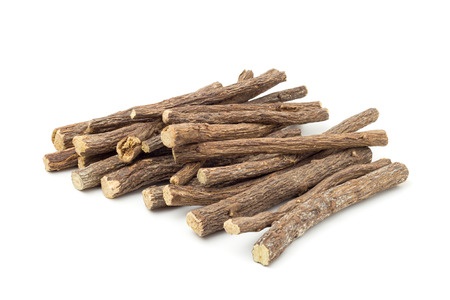
Licorice (US spelling) or Liquorice (UK spelling) has been used in ancient medicines for millennia and it’s also an extremely important flavouring for confectionary, spirits like gin and any other product that lends its particular flavour.
Sources Of Liquorice/Licorice
Liquorice is member of the Leguminosae family and is one of the Glycyrrhiza species. The commercially used species of licorice plants are Glycyrrhiza glabra, G. uralensis, G. echinata, and G. inflata (Shou-Chuan and Yu-Yi 1977). Glycyrrhiza glabra is perhaps now the most important commercially liquorice root on the market.
Chinese licorice (G. inflata) is as its name suggests sourced mainly from China. Extracts of this species are commonly found in cosmetics.
Medical Properties Of Liquorice/Licorice
There are many excellent reviews on the medicinal properties of the plant (Duke, 1997; Vora and Testa 1997).
Real interest in its anti-ulcer and anti-inflammatory properties took off immediately after the Second World War when Revers found that an extract could ‘cure’ gastric ulcer (Revers 1946). The flavour has always been of considerable interest to the Northern Europeans as a flavour for confectionary but with plenty of anecdotal evidence to emphasise its curative properties as in The Netherlands.
Over many years, the National Cancer Institute’s Chemoprevention Branch and Diet and Cancer Branch alongside other research institutions have conducted several research projects to evaluate the pharmacological activities of the crude form and the individual components of licorice (Mehta et al., 1997; Nishino 1997).
In Western countries, licorice has long been used as a flavouring and sweetening agent in food and tobacco products (Vora and Testa 1997).
Licorice is sold in the United States as a dietary supplement and an over-the-counter drug in different dosage forms of demulcent, expectorant, and laxative preparations (Blumenthal, 2000).
In China and the Far East, licorice is the base for many traditional medicines.
General Uses
- pastilles and compound tablets for sore throats and rough coughs.
- cough syrup
- dry mouth
- chewing gum,
- toothpaste
- shampoo, shower gels, soaps, washing lotions
- lipsticks, lip care products, lip balms
- facial masks especially skin cleansing and soothing balms
- skincare creams
- suncare products especially for those with sensortive skin
- natural cosmetic products
- cosmaceuticals
- flavourings for gin
Components In Licorice
The main saponin constituent and flavour is glycyrrhizin or rather glycyrrhizic acid which is a triterpene glycoside. It is a tribasic saponin composed of a triterpenoid aglycone, glycyrrhetic acid joined to a disaccharide of glucuronic acid.
It has been proven to be one of the most effective agents although there are specific and certain side effects that have been observed in clinical trials. These include edema or swelling, hypertension, and pseudoaldosteronism (Shibata and Saitoh, 1978).
Glycyrrhizin is extracted from the roots of the liquorice plant where it occurs naturally as levels of 2 to 15 per cent of the dry matter. It is converted to a mixture of potassium and calcium salts to improve solubility. It is also converted to the ammonium form on extraction. In some cases it is sold as liquid, paste or ‘block’, or spray-dried extract.
As well as glycyrrhizin, a couple of flavonoid compounds that were isolated from licorice have been extensively studied recently with regard to the various pharmacological activities (Ma et al., 2001; Friis-Moller et al., 2002; Fukai et al., 2002; Kent et al., 2002; Yamazaki et al., 2002). They are classified chemically into chalcones, flavanones, flavones, flavonols, isoflavones, isoflavanone, pterocarpan, coumestans, 3-arylcoumarins, isoflavenes, and isoflavans (Shibata and Saitoh, 1978).
One chalcone, a retrochalcone in fact has generated a great deal of interest. This is licochalcone A and B. The A form is known to have anti-inflammatory properties as well as being an antibacterial and an antiparasitic agent.
Flavour Of Liquorice/Licorice
It is a strong sweetening glycoside not too dissimilar to stevioside and related stevia glycosides like rebaudioside in terms of aftertaste and bitterness. This component is commercially extracted from the root and is a modifier of other flavours.
Most sources come from suppliers in Central Asia, China and the Mediterranean region.
Licorice In Cosmetics
Extracts of licorice are now used in cosmetics because they contain dermatologically agent called licochalcone A.
Regulatory Status For Licorice
The base products such as monoammonium glycyrrhizinate and ammoniated glycyrrhizin are approved for use in the foods in the USA, Europe, Australia, India and China amongst other countries. It currently has a wider spread than Luo han Guo fruit for example and the mogrosides.
As well as being a sweetener, liquorice extracts and glycyrrhizin are FEMA GRAS for a wide range of flavouring uses in the USA. Liquorice and its derivatives are generally regarded as safe (GRAS) by the FDA under 21 CTR 184 1408. It must be used within specified limits and for use as a flavour enhancer, flavour and in beverages, as a surfactant.
The EU register of flavouring substances lists glycyrrhizinic acid and its ammonium salt. There are concerns about the pharmacological effects of glycyrrhizin which have meant the application or rather imposition of special labelling requirements (EC, 2004) warning consumers of glycyrrhizin contents above either 100 mg/kg in confectionary or 10 mg/l in beverages. One issue is that significantly higher contents than needed can trigger more explicit warnings for consumers with hypertension.
The EU Scientific Committee for Food (SCF) has not set an ADI yet for glycyrrhizin because of a lack of high quality toxicology data. It is recommended that individuals limit their intake to 100 mg/day (SCF, 2003). The Japanese government recommends no more than 200 mg/day. The Netherlands who are keen liquorice consumers, are requested to keep their consumption to less than 200 mg glycyrrhizin which corresponds to about 150g of confectionary.
Please note this page contains links to our affiliate marketing partner. Please refer to our affiliate disclosure.
Purchase your Licorice products here
Legal Disclaimer Concerning Products On This Web-Site
The products and the information provided about specific products on or through this site have not been evaluated by the United States Food and Drug Administration or by any other national regulatory body and are not intended to diagnose, treat, cure or prevent disease. The information provided on this site is for informational purposes only and is not intended as a substitute for advice from your physician/doctor or other health care professional or any information contained on or in any product label or packaging. You should not use the information on this site for diagnosis or treatment of any health problems or for prescription of any medication or other treatment. You should consult with a healthcare professional before starting any diet, exercise or supplementation program, before taking any medication or if you suspect you might have a health problem.
References
Blumenthal M. (2000) Herbal medicine. Expanded Commission E monographs. Newton, Mass.: Integrative Medicine Communications. pp 233–9.
Duke J. (1997) Phytochemical constituents in licorice. In: Lachance PA, editor. Nutraceuticals: Designer Foods. III. Garlic, Soy and Licorice. Trumbull, Conn.: Food & Nutrition Press. pp 259–64
Friis-Moller, A., Chen, M., Fuursted, K., Christensen, S.B., Kharazmi, A. (2002) In vitro antimycobacterial and antilegionella activity of licochalcone A from Chinese licorice roots. Planta Med. 68 pp. 416–9
Fukai T, Marumo A, Kaitou K, Kanda T, Terada S, Nomura T. (2002) Anti-Helicobacter pylori flavonoids from licorice extract. Life Sci. 71 pp. 1449–63.
Fukai T, Tantai L, Nomura T. (1996) Isoprenoid-substituted flavonoids from Glycyrrhiza Glabra. Phytochemistry 43 pp. 531–2.
Kent UM, Aviram M, Rosenblat M, Hollenberg PF. 2002. The licorice root derived isoflavan glabridin inhibits the activities of human cytochrome P450S 3A4, 2B6 and 2C9. Drug Metab Dispos 30 pp. 709–15.
Ma, J., Fu, N.Y., Pang, D.B., Wu, W.Y., Xu, A.L. (2001) Apoptosis induced by isoliquiritigenin in human gastric cancer MGC-803 cells. Planta Med. 67 pp. 754–7.
Mehta, R.G., Steele, V., Pierson, H., Constantinou, A, Moon, R.C. (1997) Licorice: absorption, distribution, metabolism and cancer chemoprevention. In: Lachance PA, editor. Nutraceuticals: designer foods. III. Garlic, Soy And Licorice. Trumbull, Conn.: Food & Nutrition Press. pp. 265–78.
Nishino H. (1997) Cancer prevention by licorice. In: Lachance PA, editor. Nutraceuticals: designer foods. III. Garlic, Soy And Licorice.. Trumbull, Conn.: Food & Nutrition Press. pp. 279–83.
Revers, F.E. (1946) Ned. Tijdschr Geneesk 90 pp. 135.
Shibata, S., Saitoh, T. (1978) Flavonoid compounds in licorice root. J. Indian Chem. Soc. LV pp. 1184–91
Shou-Chuan, L., Yu-Yi, T. (1977) A study on the utilization of six species of Glycyrrhiza from China. Acta Phytotax Sin 15:pp. 47.
Vora, P.S., Testa, L.C.A. (1997) Phytochemistry of licorice horticultural and processing procedures. In: Lachance PA, editor. Nutraceuticals: Designer Foods. III. Garlic, Soy and Licorice. Trumbull, Conn.: Food & Nutrition Press. p 243–57
Yamazaki, S., Morita, T., Endo, H., Hamamoto, T., Baba, M., Joichi, Y., Kaneko ,S., Okada, Y., Okuyama, T., Nishino, H., Tokue A. (2002) Isoliquiritigenin suppresses pulmonary metastasis of mouse renal cell carcinoma. Cancer Lett. 183 pp. 23–30.

Leave a Reply